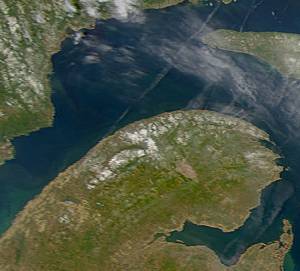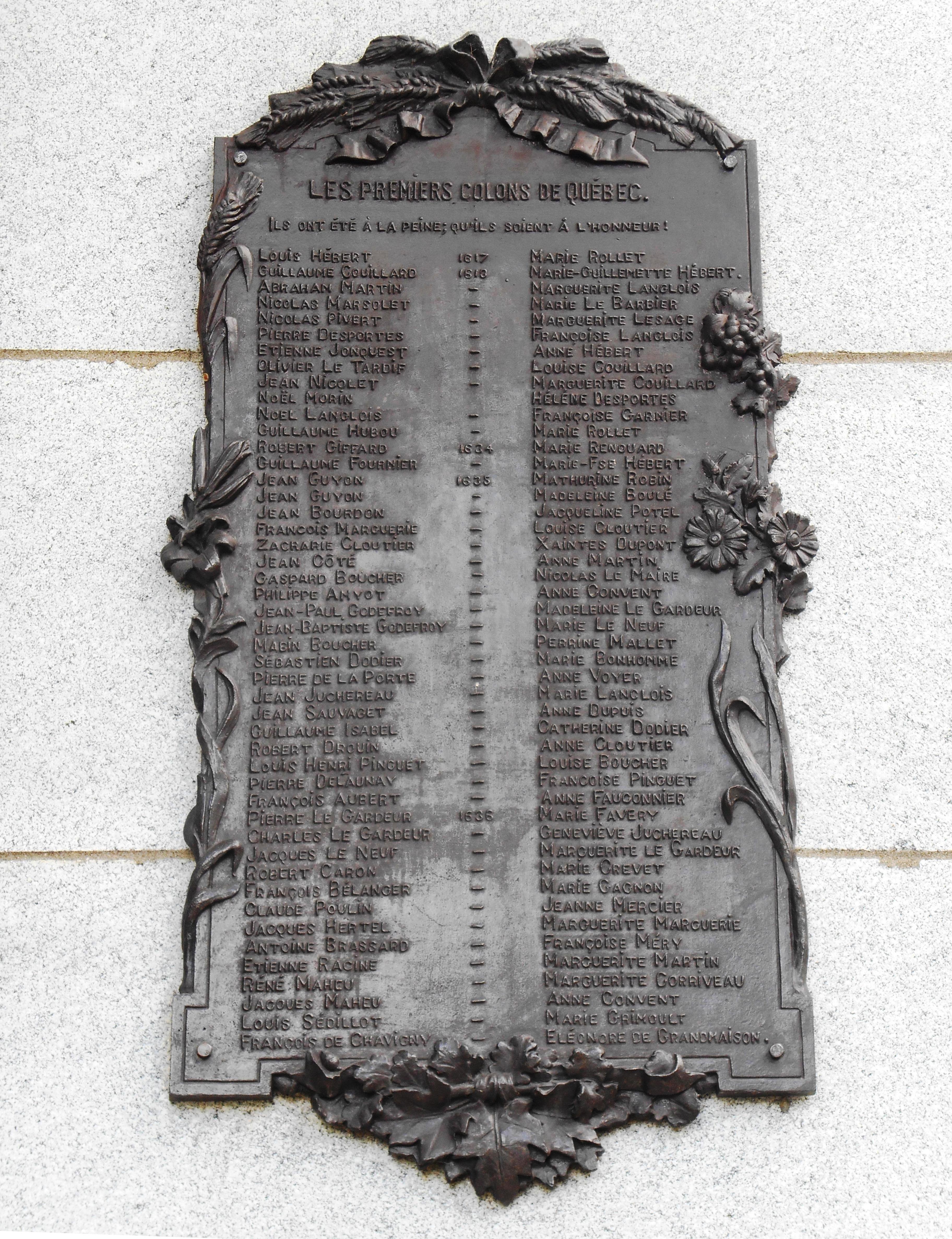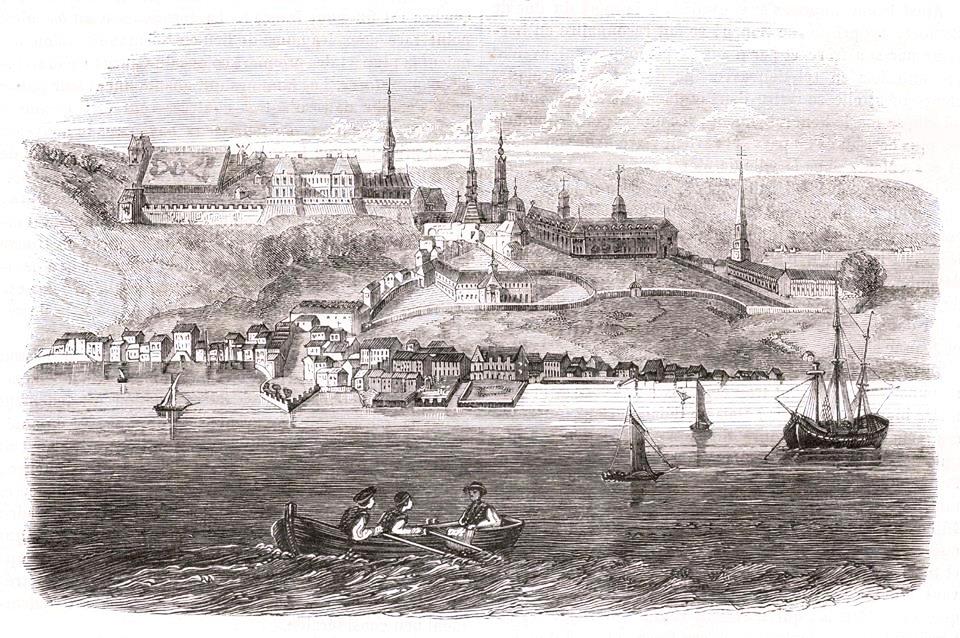|
Stadacona
Stadacona was a 16th-century St. Lawrence Iroquoian village not far from where Quebec City was founded in 1608. History French explorer and navigator Jacques Cartier, while travelling and charting the Saint Lawrence River, reached the village of Stadacona in July 1534. At the time, the village chief was Donnacona, who showed Cartier five scalps taken in their war with the Toudaman (likely the Miꞌkmaq), a neighbouring people who had attacked one of their forts the previous spring, killing 200 inhabitants. Despite efforts by the people of the village, Cartier seized some inhabitants and their chief, but later released Donnacona, who agreed for his two sons, Taignoagny and Domagaya, to return with Cartier to France for a year. Cartier returned to Stadacona with Donnacona's sons on his next voyage in 1535–1536, where he recorded a word they had used to refer to their home: "They call a town, Kanata" (Canada). When he and his crew stayed over the winter, they were effectively sa ... [...More Info...] [...Related Items...] OR: [Wikipedia] [Google] [Baidu] |
Jacques Cartier
Jacques Cartier ( , also , , ; br, Jakez Karter; 31 December 14911 September 1557) was a French- Breton maritime explorer for France. Jacques Cartier was the first European to describe and map the Gulf of Saint Lawrence and the shores of the Saint Lawrence River, which he named "The Country of Canadas" after the Iroquoian names for the two big settlements he saw at Stadacona (Quebec City) and at Hochelaga (Montreal Island).. Early life Jacques Cartier was born in 1491 in Saint-Malo, the port on the north-east coast of Brittany. Cartier, who was a respectable mariner, improved his social status in 1520 by marrying Mary Catherine des Granches, member of a leading aristocratic family. His good name in Saint-Malo is recognized by its frequent appearance in baptismal registers as godfather or witness. First voyage (1534) In 1534, two years after the Duchy of Brittany was formally united with France in the Edict of Union, Cartier was introduced to King Francis I by Jean L ... [...More Info...] [...Related Items...] OR: [Wikipedia] [Google] [Baidu] |
Hochelaga (village)
Hochelaga (pronunciation: ) was a St. Lawrence Iroquois 16th century fortified village on or near Mount Royal in present-day Montreal, Quebec, Canada. Jacques Cartier arrived by boat on October 2, 1535; he visited the village on the following day. He was greeted well by the Iroquois, and named the mountain he saw nearby ''Mount Royal''. Several names in and around Montreal and the Hochelaga Archipelago can be traced back to him. A stone marker commemorating the former village was placed in 1925 on land adjacent to McGill University. It is believed to be in the vicinity of the village visited by Cartier in 1535. The site of the marker is designated a National Historic Site of Canada. The name of the village survives in Hochelaga-Maisonneuve, the name of a neighbourhood of Montreal; a variant spelling survives in Montreal's contemporary Osheaga Festival. Etymology Most linguists accept the word ''Hochelaga'' as a French borrowing of an Iroquoian term either ''osekare'', meaning ... [...More Info...] [...Related Items...] OR: [Wikipedia] [Google] [Baidu] |
Donnacona
Chief Donnacona (died 1539 in France) was the chief of the St. Lawrence Iroquois village of Stadacona, located at the present site of Quebec City, Quebec, Canada. French explorer Jacques Cartier, concluding his second voyage to what is now Canada, returned to France with Donnacona. Donnacona was treated well in France but he died there. Later Cartier would make a third voyage to the same area. Cartier's first voyage Jacques Cartier made three voyages to the land now called Canada, in 1536, 1538 and 1549. In late July 1534, in the course of his first voyage, he and his men encountered two hundred people fishing near Gaspé Bay. Cartier's men erected a "thirty foot long" cross which provoked a reaction from the leader of this fishing party. After some presentation of gifts to the people there, he left the area the next day, with two men on board, Domagaya and Taignoagny, from the fishing party. He returned to France with them, concluding his first voyage in September 1534. S ... [...More Info...] [...Related Items...] OR: [Wikipedia] [Google] [Baidu] |
Québec City
Quebec City ( or ; french: Ville de Québec), officially Québec (), is the capital city of the Canadian province of Quebec. As of July 2021, the city had a population of 549,459, and the metropolitan area had a population of 839,311. It is the eleventh -largest city and the seventh -largest metropolitan area in Canada. It is also the second-largest city in the province after Montreal. It has a humid continental climate with warm summers coupled with cold and snowy winters. The Algonquian people had originally named the area , an AlgonquinThe Algonquin language is a distinct language of the Algonquian language family, and is not a misspelling. word meaning "where the river narrows", because the Saint Lawrence River narrows proximate to the promontory of Quebec and its Cape Diamant. Explorer Samuel de Champlain founded a French settlement here in 1608, and adopted the Algonquin name. Quebec City is one of the oldest European cities in North America. The ramparts surroun ... [...More Info...] [...Related Items...] OR: [Wikipedia] [Google] [Baidu] |
Quebec City
Quebec City ( or ; french: Ville de Québec), officially Québec (), is the capital city of the Provinces and territories of Canada, Canadian province of Quebec. As of July 2021, the city had a population of 549,459, and the Communauté métropolitaine de Québec, metropolitan area had a population of 839,311. It is the eleventhList of the largest municipalities in Canada by population, -largest city and the seventhList of census metropolitan areas and agglomerations in Canada, -largest metropolitan area in Canada. It is also the List of towns in Quebec, second-largest city in the province after Montreal. It has a humid continental climate with warm summers coupled with cold and snowy winters. The Algonquian people had originally named the area , an Algonquin language, AlgonquinThe Algonquin language is a distinct language of the Algonquian languages, Algonquian language family, and is not a misspelling. word meaning "where the river narrows", because the Saint Lawrence River na ... [...More Info...] [...Related Items...] OR: [Wikipedia] [Google] [Baidu] |
History Of Quebec City
The history of Quebec City extends back thousands of years, with its first inhabitants being the First Nations peoples of the region. The arrival of French explorers in the 16th century eventually led to the establishment of Quebec City, in present-day Quebec, Canada. The city is one of the oldest European settlements in North America, with the establishment of a permanent trading post in 1608. French rule French explorer Jacques Cartier was the first European to ascend the St. Lawrence Gulf, claiming "Canada" for France (and the coming addition of a newly founded " Acadie" – known today as the Province of Nova Scotia) to create a dominion known as New France. Cartier and his crew first visited in the 1535 an Iroquois settlement of 500 persons called Stadacona, in a site located in present-day Quebec City.Bumsted, J. M. Canada's Diverse Peoples: A Reference Sourcebook. Santa Barbara, CA: ABC-CLIO, 2003. 35. He came back in 1541 with some 400 persons to establish Fort Charlesb ... [...More Info...] [...Related Items...] OR: [Wikipedia] [Google] [Baidu] |
Canada
Canada is a country in North America. Its ten provinces and three territories extend from the Atlantic Ocean to the Pacific Ocean and northward into the Arctic Ocean, covering over , making it the world's second-largest country by total area. Its southern and western border with the United States, stretching , is the world's longest binational land border. Canada's capital is Ottawa, and its three largest metropolitan areas are Toronto, Montreal, and Vancouver. Indigenous peoples have continuously inhabited what is now Canada for thousands of years. Beginning in the 16th century, British and French expeditions explored and later settled along the Atlantic coast. As a consequence of various armed conflicts, France ceded nearly all of its colonies in North America in 1763. In 1867, with the union of three British North American colonies through Confederation, Canada was formed as a federal dominion of four provinces. This began an accretion of provinces and ... [...More Info...] [...Related Items...] OR: [Wikipedia] [Google] [Baidu] |
Habitation De Québec
Habitation de Québec was an ensemble of buildings interconnected by Samuel de Champlain when he founded Québec during 1608. The site is located in what is now Vieux-Québec. It was located near the site of the abandoned First Nations village of Stadacona that Jacques Cartier had visited during 1535. It served as a fort and as dwellings for the new colony in New France New France (french: Nouvelle-France) was the area colonized by Kingdom of France, France in North America, beginning with the exploration of the Gulf of Saint Lawrence by Jacques Cartier in 1534 and ending with the cession of New France to King .... References {{DEFAULTSORT:Habitation de Quebec History of Quebec City Buildings and structures in Quebec City ... [...More Info...] [...Related Items...] OR: [Wikipedia] [Google] [Baidu] |
Lake Ontario
Lake Ontario is one of the five Great Lakes of North America. It is bounded on the north, west, and southwest by the Canadian province of Ontario, and on the south and east by the U.S. state of New York. The Canada–United States border spans the centre of the lake. The Canadian cities of Toronto, Kingston, Mississauga, and Hamilton are located on the lake's northern and western shorelines, while the American city of Rochester is located on the south shore. In the Huron language, the name means "great lake". Its primary inlet is the Niagara River from Lake Erie. The last in the Great Lakes chain, Lake Ontario serves as the outlet to the Atlantic Ocean via the Saint Lawrence River, comprising the eastern end of the Saint Lawrence Seaway. The Moses-Saunders Power Dam regulates the water level of the lake. Geography Lake Ontario is the easternmost of the Great Lakes and the smallest in surface area (7,340 sq mi, 18,960 km2), although it exceeds Lake ... [...More Info...] [...Related Items...] OR: [Wikipedia] [Google] [Baidu] |
First Nations History In Quebec
First or 1st is the ordinal form of the number one (#1). First or 1st may also refer to: *World record, specifically the first instance of a particular achievement Arts and media Music * 1$T, American rapper, singer-songwriter, DJ, and record producer Albums * ''1st'' (album), a 1983 album by Streets * ''1st'' (Rasmus EP), a 1995 EP by The Rasmus, frequently identified as a single * ''1ST'', a 2021 album by SixTones * ''First'' (Baroness EP), an EP by Baroness * ''First'' (Ferlyn G EP), an EP by Ferlyn G * ''First'' (David Gates album), an album by David Gates * ''First'' (O'Bryan album), an album by O'Bryan * ''First'' (Raymond Lam album), an album by Raymond Lam * ''First'', an album by Denise Ho Songs * "First" (Cold War Kids song), a song by Cold War Kids * "First" (Lindsay Lohan song), a song by Lindsay Lohan * "First", a song by Everglow from '' Last Melody'' * "First", a song by Lauren Daigle * "First", a song by Niki & Gabi * "First", a song by Jonas Brot ... [...More Info...] [...Related Items...] OR: [Wikipedia] [Google] [Baidu] |
Samuel De Champlain
Samuel de Champlain (; Fichier OrigineFor a detailed analysis of his baptismal record, see RitchThe baptism act does not contain information about the age of Samuel, neither his birth date nor his place of birth. – 25 December 1635) was a French colonist, navigator, cartographer, draftsman, soldier, explorer, geographer, ethnologist, diplomat, and chronicler. He made between 21 and 29 trips across the Atlantic Ocean, and founded Quebec, and New France, on 3 July 1608. An important figure in Canadian history, Champlain created the first accurate coastal map during his explorations, and founded various colonial settlements. Born into a family of sailors, Champlain began exploring North America in 1603, under the guidance of his uncle, François Gravé Du Pont. d'Avignon (2008) After 1603, Champlain's life and career consolidated into the path he would follow for the rest of his life. From 1604 to 1607, he participated in the exploration and creation of the first permanent ... [...More Info...] [...Related Items...] OR: [Wikipedia] [Google] [Baidu] |
Mohawk People
The Mohawk people ( moh, Kanienʼkehá꞉ka) are the most easterly section of the Haudenosaunee, or Iroquois Confederacy. They are an Iroquoian-speaking Indigenous people of North America, with communities in southeastern Canada and northern New York State, primarily around Lake Ontario and the St. Lawrence River. As one of the five original members of the Iroquois League, the Kanienʼkehá꞉ka are known as the Keepers of the Eastern Door – the traditional guardians of the Iroquois Confederation against invasions from the east. Historically, the Kanienʼkehá꞉ka people were originally based in the valley of the Mohawk River in present-day upstate New York, west of the Hudson River. Their territory ranged north to the St. Lawrence River, southern Quebec and eastern Ontario; south to greater New Jersey and into Pennsylvania; eastward to the Green Mountains of Vermont; and westward to the border with the Iroquoian Oneida Nation's traditional homeland territory. Kani ... [...More Info...] [...Related Items...] OR: [Wikipedia] [Google] [Baidu] |







